Abstract
Debris flows are rapid mass movements of water-laden debris that flow down mountainsides into valley channels and eventually settle on valley floors. The risk of debris flows can be significantly increased after wildfires. Following the destructive 2021 debris flows in Glenwood Canyon, the Colorado Geological Survey (CGS) initiated a LiDAR-Based Alluvial Fan Mapping Project to improve geologic hazard delineation of alluvial and high-angle fans in response to developing wildfire-ready watersheds. These landforms, shaped by episodic sediment-laden flows, pose significant risks and are often misrepresented on conventional geologic maps. CGS delineated fan-shaped landforms with improved precision using 1-m resolution LiDAR-based DEMs, DEM-derived terrain metrics, hydrologic analysis, and geospatial analysis tools within the ArcGIS Pro platform. Our results reveal previously unmapped or misclassified alluvial or high-angle fans in areas undergoing increasing development pressure, where low-gradient terrain indicates a high hazard potential. Through this study, over 3200 alluvial and high-angle fan polygons were delineated across six Colorado counties, encompassing approximately 81 km2 of alluvial fans and 54 km2 of high-angle fans. High-resolution LiDAR data, geospatial analytical techniques, and systematic QA/QC protocols were used to support refined hazard awareness. The resulting dataset enhances proactive land-use planning and wildfire resilience by identifying areas prone to debris flow and flood hazards. These maps are intended for regional screening and planning purposes and are not intended for site-specific design. These maps also serve as a critical resource for prioritizing geologic evaluations and guiding mitigation planning across Colorado’s wildfire-affected landscapes.
1. Introduction
1.1. Background
Debris flows often occur after intense rainfall in recently burned areas, where the removal of vegetation exposes soil to erosion and leads to changes in soil structure, including increased hydrophobicity and reduced infiltration capacity. Wildfires exacerbate these effects by destroying root systems, altering soil chemistry, and creating water-repellent layers, all of which reduce infiltration and promote rapid runoff. As a result, even moderate rainstorms can trigger debris flows in post-fire landscapes, posing significant hazards downstream [1,2,3,4].
This study is motivated by recent catastrophic debris flows in Colorado, particularly those in Glenwood Canyon and nearby regions, following the 2020 Grizzly Creek Fire [4], which have highlighted the limitations of existing geologic hazard maps, especially concerning alluvial and high-angle fans. These sediment-rich, fan-shaped deposits are common at mountain valley outlets and are highly susceptible to debris flows, mudflows, and flooding hazards, often exacerbated after wildfires. Many affected properties were built atop seemingly flat landforms, highlighting the disconnect between perceived and actual hazard [5]. As wildfire severity grows with climate change, improved mapping of these features is essential for hazard mitigation and planning.
This LiDAR-based alluvial fan (LAF) mapping project is intended to support wildfire-related hazard mitigation. It outlines a methodology for enhancing fan delineation using high-resolution 1 m LiDAR-based digital elevation models (DEMs), terrain derivatives, and GIS-based hydrologic analyses. It addresses the need to improve map accuracy, update geologic datasets, and support wildfire readiness. Mapping focused on six wildfire-affected Colorado counties (Pitkin, Boulder, Clear Creek, Chaffee, Lake, and Gilpin), delineating over 3200 alluvial and high-angle fan polygons, covering approximately 81 km2 and 54 km2, respectively. The resulting dataset supports proactive geohazard planning across fire-prone landscapes.
1.2. Definitions and Discussion
Alluvial fans are semi-conical depositional landforms formed where sediment-laden streams emerge from confined valleys into a relatively open, flatter plain [6,7]. High-angle fans, typically steeper, may form through both fluvial and mass-wasting processes [8,9]. These features are shaped by sediment transported through drainage networks. Understanding the connection between fans and their upstream basins, including stream channels and pour points, is critical for hazard modeling and sediment transport analysis [10,11].
Figure 1 illustrates a typical alluvial fan system. At the top of the system, runoff collects within a defined basin, where tributary channels converge to form a main drainage pathway. These tributaries, flowing between ridges, transport water and sediment down the slope. As the main channel reaches the mountain front, it exits the confined terrain and reaches the apex of the alluvial fan, marked in the diagram (Figure 1) by a red dot. This apex is the transition point from erosion and transport to deposition. Beyond this point, the channel loses energy and disperses across a broader, low-gradient surface, depositing sediment in a fan-shaped pattern that defines the alluvial fan. The fan surface extends downslope to its distal edge, known as the toe of the fan, where finer materials settle and transport generally ceases. Below the surface, layers of alluvium represent these accumulated sediments. Sediment spreads downslope in a fan shape, forming layers of alluvium beneath the surface. A mountain front fault, also shown, influences uplift and sediment delivery [12]. These components reflect the interaction of tectonics, hydrology, and geomorphology in the formation of fans [6,7].
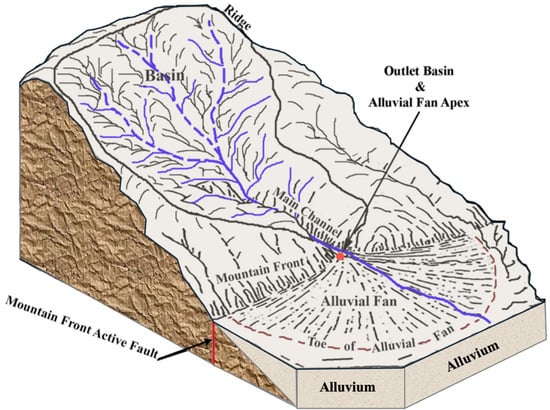
Figure 1.
Alluvial fan illustration in mountainous regions modified from [12].
Alluvial and high-angle fan landforms present unique hazard profiles. High-angle fans, with their steeper slopes and limited confinement, are more prone to rapid debris flows, shallow landslides, and channel incision. These characteristics can lead to sudden, high-energy flows with minimal warning following heavy rainstorms, posing elevated risks to infrastructure and life safety. Traditional alluvial fans typically exhibit lower gradients and broader depositional areas, where flows may be more dispersed but still hazardous. In addition, many bajadas were also observed in our study area. Bajadas are compound landforms that are created by merging adjacent fans into one individual fan. For urban planners and emergency managers, understanding where these landforms are located during and following a wildfire event is critical to addressing potential severe hazards.
Recent advances in remote sensing have significantly improved the ability to delineate and analyze alluvial and high-angle fans. High-resolution LiDAR-based DEMs are particularly effective in capturing fine-scale topographic features such as slope discontinuities, incised channels, and subtle depositional lobes that may be obscured in traditional methods. Several studies have demonstrated the utility of LiDAR in characterizing fan morphology and enhancing debris flow susceptibility assessments across diverse geographic settings [13,14,15]. These works demonstrate how LiDAR-derived terrain metrics improve reproducibility and mapping accuracy, providing a foundation for both regional hazard screening and site-specific planning. Building on these methods, our study applies similar principles to wildfire-prone landscapes in Colorado, using a systematic approach to distinguish between fan types based on slope, topographic context, and connected drainage features.
GIS (Geographic Information System) tools are essential for mapping alluvial and high-angle fans, supporting hazard assessment, planning, and resource evaluation [4,5,8,11,12,16]. These tools enable the preprocessing of LiDAR-based DEMs, terrain and hydrology analyses, and the identification of fan apexes, as well as the delineation of the lateral margins and distal edges of fan deposits. LiDAR-based elevation models have become a critical tool for identifying geomorphic features like fan apexes, slope breaks, and depositional lobes, particularly in arid and mountainous regions [17]. Additionally, they facilitate the integration of other relevant spatial data, such as land use and zoning. ArcGIS Pro 3.3 or 3.4 serves as the primary platform used for this project.
1.3. Study Sites and Focus Areas
The focus areas for this project are directly related to regions experiencing high development pressure and land use needs, as well as areas with heightened wildfire risk in western Colorado. As of Summer 2025, Figure 2 denotes the counties that have completed LAF mapping (Phase 1) and are making progress for 2025 completion (Phases 2 and 3). Other counties are scheduled for completion in 2026. The CGS and the Colorado Water Conservation Board (CWCB), which is under the Colorado Department of Natural Resources (DNR), collaborated to identify high-risk areas based on the current stakeholders’ needs.
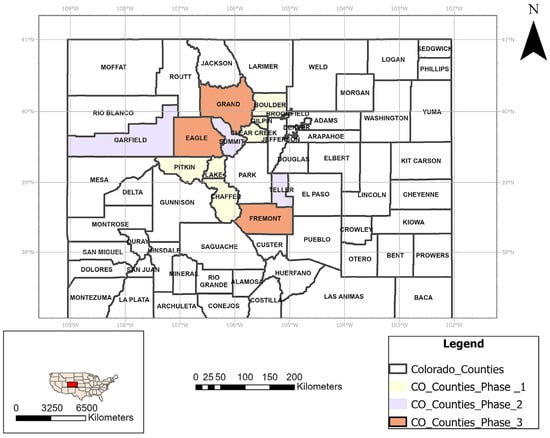
Figure 2.
Alluvial Fan Mapping Projects in Colorado.
1.4. Geomorphology and Geologic Maps of Colorado
Colorado showcases a diverse array of geomorphic features that reflect its rich geology and extensive history of surface processes. The landscape, ranging from the relatively flat eastern plains to high mountains and deep canyons, is shaped by multiple factors, such as glaciation, fluvial processes, wind, and weathering.
Geomorphology informs us about how sediment is transported, deposited, and reworked across a landscape. At the same time, geologic maps provide insight into the material composition, structural controls, and long-term processes shaping landform evolution. Understanding the geomorphic context and underlying geology is essential for accurately delineating alluvial and high-angle fans and for assessing hazards.
Figure 3 shows the 1:24,000-scale 7.5 min quadrangles in Colorado, some of which extend across state borders into Wyoming, Utah, New Mexico, Nebraska, Kansas, and Oklahoma. In total, there are approximately 1942 quadrangles, with just over 700 of these mapped. These include 382 mapped by the United States Geological Survey (USGS) and 321 mapped by CGS. These geologic maps provide critical baseline data for interpreting the genesis of landforms, subsurface conditions, and hazard susceptibility. Where geologic mapping is not yet available, LiDAR-based mapping and terrain analysis provide a foundational dataset for identifying priority zones and initiating further geologic investigations.
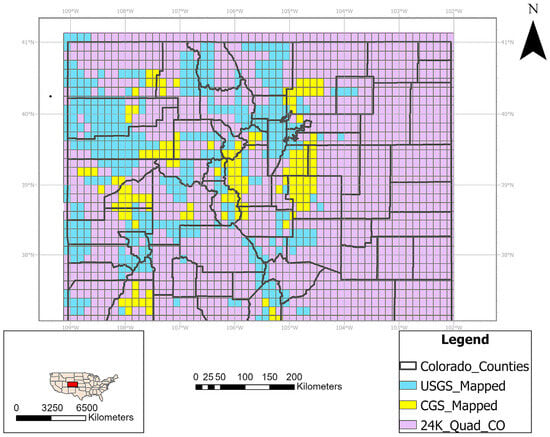
Figure 3.
Map showing 1942 24-kilometer-quadrangle geologic maps, county boundaries in Colorado, and approximately 703 24k geologic quadrangles that were mapped by the CGS (321) and USGS (382).
Figure 4 illustrates an example of a previously unmapped alluvial fan that was identified and validated in this project (Summit County to be completed by the end of 2025). Figure 4a illustrates a portion of the Geologic Map of the Breckenridge Quadrangle [18], Summit and Park Counties, Colorado. This area includes colluvial and landslide deposits (Qls, Qc) directed downslope to alluvium (Qal) deposits. Figure 4b shows the LiDAR-based alluvial fan mapped from this mapping project, depicted in purple, situated downslope of incised colluvial and landslide deposits (Qls, Qc); it is mapped within alluvium (Qal) deposits. The geology map distinguishes between depositional units, including alluvium (Qal), colluvium (Qc), and landslide deposits (Qls), each of which influences sediment sourcing and fan formation. This upstream sediment source zone supports the interpretation of fan landforms and helps identify areas susceptible to future debris flows or sediment reactivation, which acts as a sediment source. Figure 4c illustrates the alluvial fan polygon overlain on the digitized geologic map.
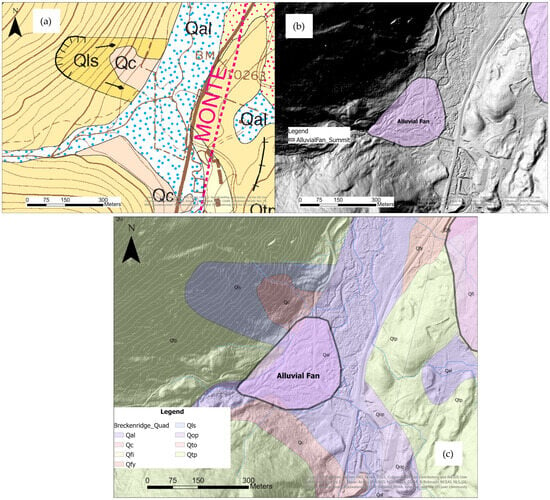
Figure 4.
(a) Portion of the geologic map of the Breckenridge Quadrangle [18], Summit and Park Counties, Colorado. (b) LiDAR-based mapping identified a previously unmapped or misclassified alluvial fan, and (c) LiDAR-based alluvial fan mapping can be used to update the geologic map [18].
Geologic maps often depict alluvial fan deposits. Geologic maps typically classify alluvial fan deposits (by age or origin), whereas geomorphologic mapping (using LiDAR) highlights the fan landform itself [19,20]. Additionally, previously published geologic maps were created before the emergence of geospatial technology, such as LiDAR-based mapping products and high-resolution DEMs, which are readily available for present-day geologists. While geologic mapping can depict alluvial fan deposits, LiDAR-based alluvial fan mapping has become a critical approach for identifying fans more precisely and extending the mapped areas compared to previous efforts, where fans were only partially mapped. Figure 5 shows an example of partially mapped alluvial fans from the Geologic Map of the Harvard Lakes Quadrangle [21], overlain by a fully mapped alluvial fan using LiDAR-based and LiDAR-derived datasets and the methodology discussed in this study.
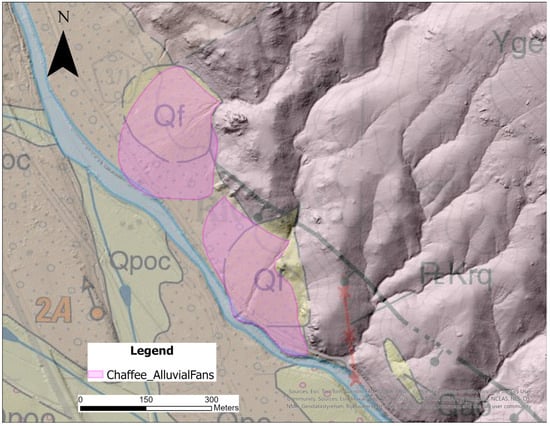
Figure 5.
A comparison of a partially mapped fan from the existing geologic map (raster) with the LiDAR-based mapping extends the mapped area to depict the entire alluvial deposits, which are indicated in the legend as pink polygons labeled as Chaffee_Alluvial Fans (LiDAR-Based Alluvial Fan Mapping Project in Chaffee County, Colorado). Qf = fan deposit, Qpoc = Channel deposits, PEkrq = Quartz rhyolite, Yge = Granite of elephant rock, with normal fault (black lines), channels (blue lines) [21].
1.5. Geologic Processes Associated with Alluvial and High-Angle Fans
Alluvial fans are part of a complex sediment transfer process that includes a contributing basin (source area), a transition point (fan apex), and a depositional landform (the fan surface) (see Figure 6). Sediment transport processes within this system include erosion, channel incision, and deposition from mudflows, debris flows, and hyper-concentrated floods. In Colorado’s mountainous terrain, debris flows are primarily runoff-generated, triggered when intense rainfall mobilizes loose surface material (possibly altered by fire) into steep channels that rapidly deliver sediment to fan surfaces [22]. These flows may initiate in headwater basins or along hillslopes and are often accompanied by avulsion at the apex of the fan, where incised channels may shift laterally during high-energy events. Consequently, the entire fan surface remains susceptible to debris flows, mudflows, flooding, and erosion. When planning development within or near alluvial fan areas, site-specific evaluation should consider the depth of flooding, the potential for mudflow or debris flow deposits, the velocity and height of these events, as well as the depth of sheet flow flooding, which is a thin, uniform layer of water over a land surface, as opposed to channel flow.
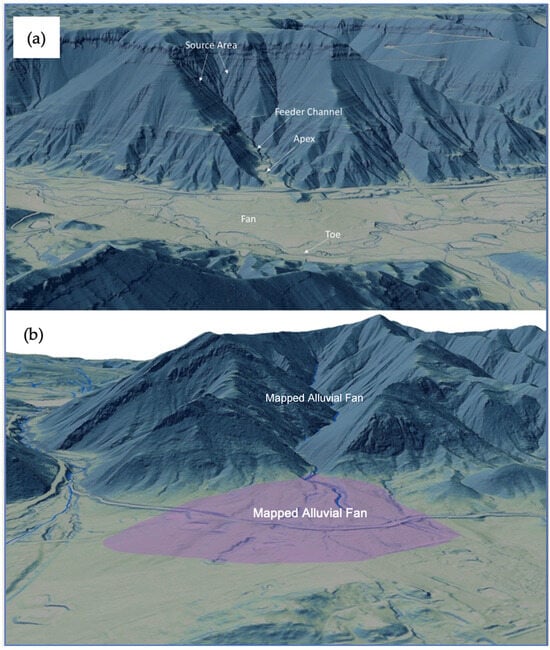
Figure 6.
(a) Three-dimensional illustrations of alluvial fan terminology and (b) a mapped alluvial fan for this study.
These geologic processes can vary across the six counties analyzed in this study. For instance, Chaffee and Pitkin Counties contain highly erodible shale units such as the Mancos Shale, which elevate the likelihood of slope failures and mudflows. Boulder and Clear Creek Counties have experienced debris flows and channel avulsions in steep, confined canyon systems during intense rainfall events. In Lake and Gilpin Counties, mixed volcanic and sedimentary bedrock contributes to shallow landslides and post-fire erosion. This regional variability emphasizes the importance of identifying fan landforms to support mitigation strategies tailored to both local geology and wildfire impacts.
The risk of flooding and debris flow hazards can lead to the destruction of buildings and fatalities. Changes in the source area (due to landslides, avalanches, flooding, etc.) increase the probability of flooding or debris flow. A wildfire in the source area that feeds the alluvial fans will significantly increase the sediment load and intensify a debris flow event.
Other hazards typically associated with alluvial fans include high groundwater and hydrocompactive/collapsible soils (hydrocompaction describes the process of volume change in a deposit of collapsible soil upon saturation with water).
2. Materials and Methods
2.1. Overview
This study employed a multi-step geospatial workflow to delineate alluvial fans in mountainous regions of Colorado using high-resolution LiDAR DEM data, DEM-derived terrain maps, hydrologic analysis, and hydro-geomorphic principles (such as the associations between hydrography and geomorphology) to support hazard assessments for post-wildfire debris flow and flooding as part of the Wildfire Ready Watersheds initiative from the Colorado Water Conservation Board.
While LiDAR has been increasingly applied to map alluvial fans in regions such as California, Europe, and Asia, many existing approaches focus on site-specific hazard mapping or rely on semi-automated geomorphic classifiers with limited QA/QC [17]. This study offers a systematic, manually validated mapping approach applied across a broad regional scale—with over 3200 fans across six Colorado counties—using consistent terrain metrics and hydrologic analysis. Unlike purely automated workflows, which may overgeneralize or misclassify fan boundaries due to slope breaks, channel complexity, anthropogenic terrain, or vegetation artifacts, our method integrates geomorphic context, visual interpretation, and slope–area relationships to improve delineation accuracy. This approach enhances transferability and reliability for regional hazard screening. It is well-suited for jurisdictions where automated tools must be supplemented by expert judgment for regulatory or land-use planning purposes.
This LAF mapping project intends to identify and map, at a scale of 1:24,000, the extent of fan landforms with unprecedented accuracy. This includes interpretations where anthropogenic activities have altered the fans (such as roadcuts, housing developments, and human-made drainage ditches). The use of 1-m-resolution LiDAR-based DEMs is essential for accurately delineating fan landforms, as finer-scale topographic data significantly enhances the detection of fan margins, slope breaks, and sediment pathways [13]. The methods for identifying fans from the available LiDAR imagery consist of three steps, which are illustrated in Figure 7.
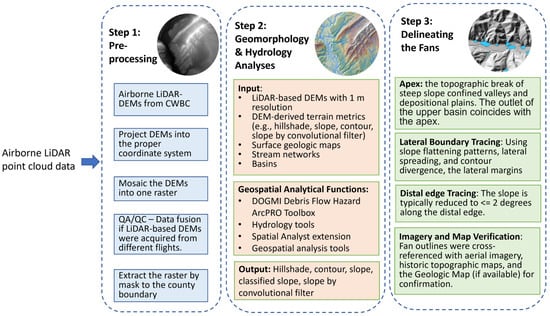
Figure 7.
Steps used for identifying fan-shaped landforms from available LiDAR data.
As outlined in Figure 7, mapping utilized ArcGIS Pro workflows including hillshade analysis, slope and classified slope maps, 0.6 to 1.5 m (2 to 5 ft) contours, and convolution filters to detect areas of steep slopes with confined stream channels. The fan landforms were digitized using a slope threshold of ≤20° for alluvial fans and >20° for high-angle fans. Recent large-scale geomorphic inventories support this 20° threshold. Notably, the Utah Division of Emergency Management’s 2023 Statewide Active Alluvial Fan Landform Inventory defines active alluvial fans as landforms with slopes ranging from 4° to 20°, emphasizing that steeper slopes tend to reflect colluvial or erosional processes rather than depositional dynamics [9]. Channel lines, catchment boundaries, and aerial imagery (e.g., Esri World Imagery, Google Earth, Wayback imagery) were used to support the placement of polygons. Distal fan edges were constrained by proximity to significant drainages or at slopes of <2°, as defined by the slope angle threshold for the toe of the fan. Furthermore, Quality Assurance and Quality Control (QA/QC) protocols included a random cross-review of 10% of polygons with adjustments for development impacts and a cross-mapper review to identify any inconsistencies in the mapping process. Field checks were conducted where access permitted, focusing on areas of human activity and recent hazard exposure. Depending on the county, about 5–10% of the mapped fans were field validated. Alluvial and high-angle fans of <2000 m2 in area were excluded to maintain map scale integrity (1:24,000).
2.2. Data Acquisition
The LiDAR-based Alluvial Fan Mapping Project utilizes superimposed datasets in ArcGIS Pro, comprising geospatial datasets derived from sources such as the USGS, CGS, and CWCB (see Table 1 for more details).

Table 1.
Summary of data acquisition.
2.3. Criteria and Mapping
Alluvial fans were delineated based on a suite of topographic and morphometric indicators derived from high-resolution elevation data. Key criteria included the following.
- Cone-Shaped Morphology: Fans exhibit a classic conical shape, often characterized by a radial pattern in contour lines indicating outward spreading from a central apex.
- Fan Apex: Located where confined channels exit mountainous areas and begin depositing on low-gradient terrain (Figure 8b).
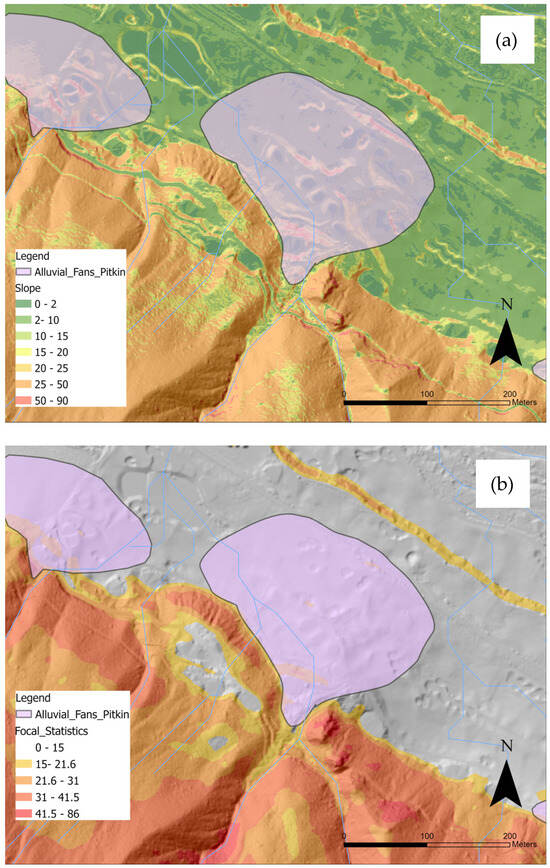 Figure 8. (a) Slope showing the distal extent of the alluvial fan and (b) convolution filter showing elevation variability across the DEM; the slope threshold is approximately 15 degrees (LiDAR-Based Alluvial Fan Mapping Project in Pitkin County, Colorado).
Figure 8. (a) Slope showing the distal extent of the alluvial fan and (b) convolution filter showing elevation variability across the DEM; the slope threshold is approximately 15 degrees (LiDAR-Based Alluvial Fan Mapping Project in Pitkin County, Colorado). - Lateral and Distal Edges: Determined from slope flattening (<2° for distal fans), contour divergence, and convex break-in-slope (Figure 8a).
- Classification:
- o
- Alluvial fans are defined by average slopes < 20°.
- o
- High-angle fans are identified where slopes exceed 20°.
A circular focal statistical analysis or convolution filter is applied to the slope map to detect areas of steep slope with confined stream channels from the areas of valley plain (Figure 8b).
2.4. Digital Terrain Processing
A suite of terrain derivatives was generated from the LiDAR-based DEM using functions in ArcGIS Pro to support landform identification. These included the following.
- Slope identifies high-angle fan areas and supports fan type classification.
- Curvature highlights concave and convex transitions to support break-in-slope detection.
- Hillshade improves the visualization of radial morphologies and geomorphic breaks.
- Contours with 2 to 5 m interval support identification of radial patterns and slope transitions.
- Focal Statistics (range filter) highlights local elevation variation and emphasize depositional breaks.
2.5. Hydrology Analysis Using DOGAMI
DOGAMI Debris Flow Hazard ArcPRO Toolbox was used [23]. The Colorado Geological Survey developed two Python (version 3.11)–scripted toolboxes based on DOGAMI’s Hazards Generator Toolbox to obtain base maps, initiation and transport, basins, and channel transport potential based on channel confinement and gradient. The DOGAMI tools were applied using 1 m DEMs with a flow accumulation threshold of 200 cells for stream network extraction. The CGS customized the toolbox by incorporating Colorado-specific slope-weighting and landcover parameters (refer to the DOGAMI Protocol for Channelized Debris Flow Susceptibility Mapping) [23].
Based on DOGAMI’s Debris Flow Hazard Tool and refined by CGS using a Digital Elevation Model (DEM), the Channel dataset is a polyline shapefile that represents connected channels contributing sediment and water to feed the fans. This dataset incorporates detailed hydrological analyses, including the following.
- Flow direction and accumulation rasters derived from the DEM.
- Catchments and pour points generated using the Arc Hydro toolbox.
- Connectivity: Each fan polygon was intersected with modeled flow paths and stream vectors to verify linkage with contributing basins and drainage outlets.
This tool helps to define stream networks and highlights primary channels that are susceptible to debris flows.
2.6. Fan Delineation Workflow
Based on the methods and methodology outlined above, Figure 9 below shows the visual interpretation of our fan delineation workflow for this project. The fan delineation workflow also includes QA/QC and field check processes, which provide feedback for revisions of the maps. These processes are iterative before the maps are stored in geodatabases and shared with the stakeholders and the general public.
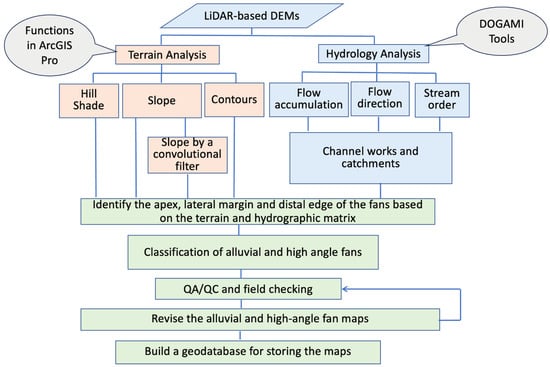
Figure 9.
The fan delineation workflow, which includes terrain analysis, surface geologic mapping, and hydrology analysis, is used to delineate the fans.
2.7. QA/QC Protocol
To ensure data accuracy and consistency, Quality Assurance and Quality Control (QA/QC) were conducted systematically throughout the project. Ten percent of the initially digitized fan polygons were randomly selected and reviewed by a different mapper. The location of the fan apex, the fan shape, and the distal edge were closely examined. Approximately 15–25% of polygons required adjustment during QA/QC. The most common discrepancies included the following:
- Apex misplacement due to channel complexity,
- Overextension of distal fan boundaries into floodplains or anthropogenic surfaces (e.g., roads and leveled construction pads),
- Misclassification of terraces or colluvial aprons as fan surfaces, particularly in areas with overlapping geomorphic features.
Corrections were made by refining apex locations, adjusting lateral margins, and reclassifying landforms where necessary. The QA/QC process ensured consistent polygon geometry and classification across all six counties.
QA/QC is crucial for minimizing errors, ensuring data quality, and meeting the needs of stakeholders. It allowed the created dataset to be effectively utilized in analysis, planning, and decision-making.
3. Results
3.1. Summary of the Results as of June 2025
The CGS LAF mapping project has finished and published the first iteration (Version 1) of datasets for six counties (Table 2), with a few more counties currently undergoing QA/QC and internal review. Preliminary mapping in six counties delineated over 3200 alluvial and high-angle fan polygons with a total area of alluvial fans of about 81 km2 and a total area of high-angle fans of about 54 km2. Highlights for these counties are further discussed in Section 3.2 and Section 3.3. Figure 10 shows a graphical display of the number of fans for each county.

Table 2.
Summary of alluvial and high-angle fans.
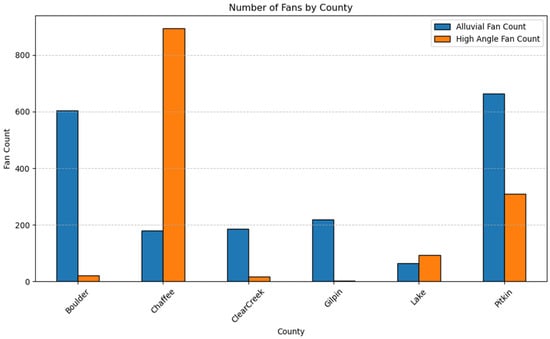
Figure 10.
Bar chart showing a graphical display of the fans by county.
Chaffee County’s high count of high-angle fans (894) reflects its steep mountainous terrain and extensive talus development. In contrast, Gilpin, Boulder, and Clear Creek Counties’ lower numbers may relate to broader valleys and a higher frequency of coalesced bajadas. Pitkin County’s high-angle fans (309) were somewhat lower than Chaffee County’s, due in part to the river valleys and slope delineation across Pitkin County that is significantly different from that in Chaffee County.
The project identified many fans not previously included in geological hazard inventories and reclassified several misidentified landforms. Following the identification of the alluvial fan landforms within the project focus areas and using the data sources described previously, a series of field checks were conducted at many selected locations. The primary purpose of the ground-truthing was to verify geomorphic characteristics and features observed in mapping and confirm fan extents in developed areas, particularly in zones of post-fire debris flow damage. The field mapping also documented complex depositional zones with mixed colluvial and alluvial signatures, emphasizing the need for integrated classification criteria.
QA/QC reviews led to polygon refinement in over 15–25% of initial cases, primarily due to anthropogenic modification or stream incision. DEMs and fan slope statistics supported the separation of high-angle fans from conventional fan shapes, informing potential hazard thresholds.
Local geologic and topographic conditions—such as steep gradients, highly fractured rock (e.g., granitic and schistose bedrock), and narrow canyons in counties like Pitkin and Clear Creek—intensify the post-fire debris flow response. These features promote rapid runoff and sediment mobilization after wildfire events, especially when hydrophobic soils develop. The combination of steep terrain and recent fire activity (e.g., Grizzly Creek and other regional burns) makes these areas particularly susceptible to debris flows. It highlights the importance of fan mapping to guide land-use decisions.
The following sections illustrate the specific results generated from this project using Clear Creek and Pitkin Counties as examples. Clear Creek County and Pitkin County are both within mountainous terrain in Colorado.
3.2. Clear Creek County
Clear Creek County spans an area of 1030 square kilometers (396 square miles) and exhibits a diverse geomorphology shaped by its geological history, including mountain building, faulting, uplift, and erosion. Rugged mountains, deep canyons such as Clear Creek Canyon, and various glacial and alluvial sediments characterize the landscape. This region has undergone several episodes of folding and faulting, resulting in the development of distinct rock types and formations. Figure 11 displays a portion of the county with many mapped alluvial fans and a few high-angle fans. The Clear Creek and its tributaries are also shown in the figure.
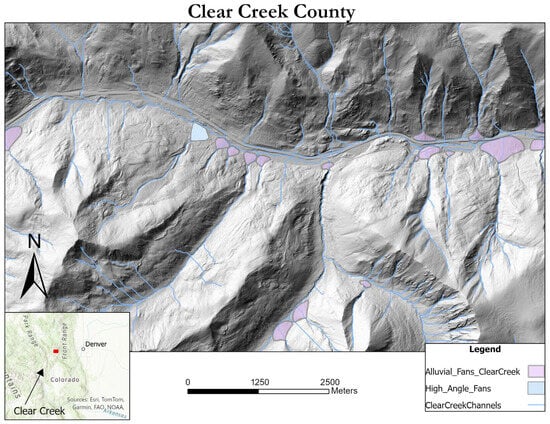
Figure 11.
Mapped alluvial fans in a portion of Clear Creek County.
Figure 12 focuses on the distribution of existing structures across the 81 mapped alluvial fans in Clear Creek County. Building density varies significantly, with counts ranging from 1 to 115 structures per fan. The mean density is 8.96 buildings, but the high standard deviation of 17.11 and a maximum of 115 buildings reflect substantial variability. Most fans have relatively few buildings, with 25% having only one or fewer structures and a median of three. The map visualization (Figure 12a) highlights buildings (orange polygons) located within alluvial fan areas (outlined in pink) and their surrounding terrain. Connected channels (blue lines) emphasize hydrological pathways, while a grayscale hillshade background provides a detailed view of the fan’s topography. A concentration of buildings in the central portion of certain fans suggests significant development in high-risk zones, increasing susceptibility to hazards such as erosion, flooding, and debris flows.
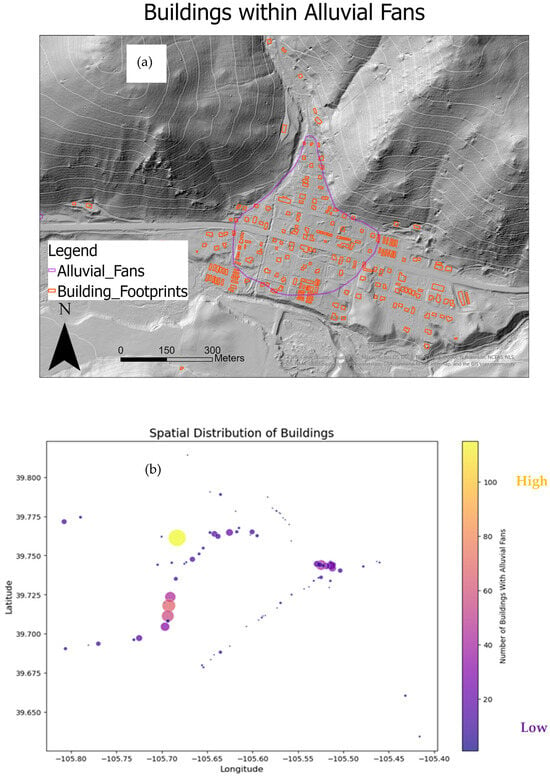
Figure 12.
(a) Existing structures associated with the alluvial fans in Clear Creek County. (b) Spatial distribution of buildings within fans in Clear Creek County.
The spatial plot (Figure 12b) illustrates the geographic distribution of buildings within the fan for the entire county using point size and color to reflect building density. Larger, brighter points (yellow-orange) represent fans with higher building counts, while smaller, darker points (purple) indicate fans with fewer structures. Clusters of high-density fans are evident in urbanized areas, whereas sparsely populated fans appear in more isolated regions.
This analysis indicates that fans with high building densities are identified as priority areas for mitigation due to their increased vulnerability to natural hazards. This analysis highlights the significance of integrating building data into hazard assessments and implementing targeted strategies to mitigate risks in developed areas within alluvial fan boundaries. Effective measures may include stricter zoning regulations, infrastructure upgrades, and enhanced community awareness of geomorphic hazards.
3.3. Pitkin County
Pitkin County encompasses approximately 973 square miles (2520 square kilometers) and exhibits a range of geomorphological features shaped by its mountainous terrain, glacial past, and river systems. This region encompasses the Elk Mountains, which include Aspen Mountain and the Roaring Fork River valley. Common geomorphologic studies in the areas include investigating river stability, the effects on wetlands, and risks associated with debris flows after wildfires. Figure 13 displays a portion of the county with many mapped alluvial fans and a few high-angle fans.
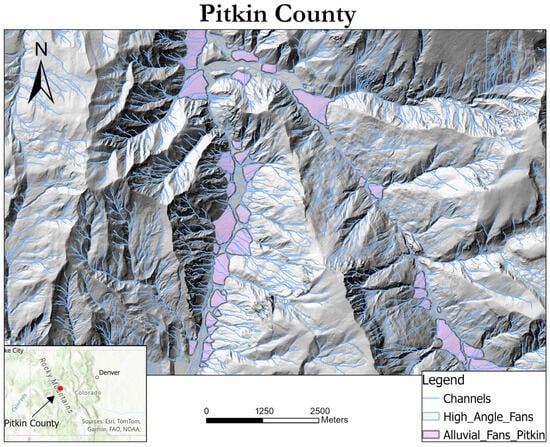
Figure 13.
Mapped alluvial fans in a portion of Pitkin County.
Figure 14 shows an image of bajada or coalesced fans in Pitkin County, Colorado. Bajadas are broad, gently sloping landforms formed by the lateral merging of adjacent alluvial fans along the base of a mountain front [8]. As individual fans prograde and expand over time, they coalesce to create a continuous apron of sediment that extends into the basin. Bajadas typically form in arid and semi-arid regions, where episodic, high-energy flow events deposit coarse sediment at the mountain front. These landforms are very common and have been identified in all the counties for this project. Unlike single, isolated fans, bajadas represent integrated depositional systems that reflect long-term sediment supply, tectonic controls, and climatic variability.
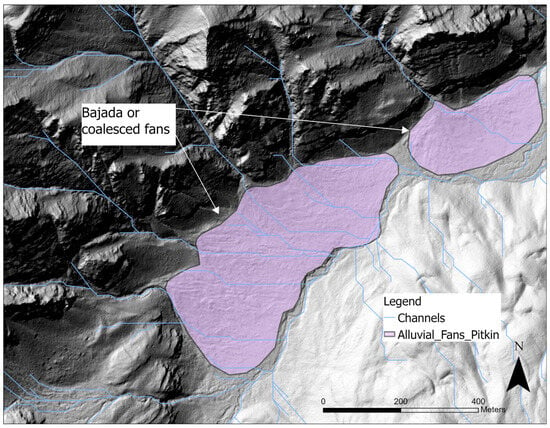
Figure 14.
A bajada or coalesced fans in Pitkin County (LiDAR-Based Alluvial Fan Mapping Project—Pitkin County).
Figure 15 shows a talus slope (outlined in yellow) along the base of a steep mountain front. Additionally, a major roadway traverses the central portion of the slope, providing a clear example of anthropogenic modification. The construction and grading associated with the road appear to have altered the natural depositional gradient, disrupting surface runoff pathways and potentially redistributing sediment downslope. This human activity complicates geomorphic interpretation and may increase the potential for localized instability or altered debris flow behavior. Such features demonstrate how infrastructure can alter natural slope processes and the importance of incorporating both natural and modified terrain into hazard assessments, particularly in mountainous regions where infrastructure intersects active geomorphic processes.
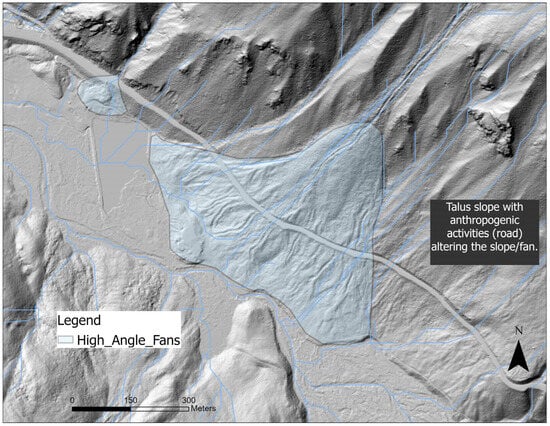
Figure 15.
Talus slope in Pitkin County with highway cutting through the fan (LiDAR-Based Alluvial Fan Mapping Project—Pitkin County).
For each county, notes and descriptions are provided in the attribute tables for each fan, highlighting whether anthropogenic activities, field checks, and other relevant observations were observed or conducted. This information, along with detailed metadata, is essential for providing the user with all the necessary tools for interpreting the dataset.
4. Discussion
This LiDAR-based mapping effort demonstrates the utility of high-resolution LiDAR data and geospatial analysis tools for identifying alluvial and high-angle fan landforms across wildfire-impacted regions of Colorado. The separation of alluvial and high-angle fans using slope-based criteria combined with convolution filtering and cross-checking protocols addresses gaps in traditional geomorphic mapping. Such tools are critical for anticipating hazard exposure in rapidly urbanizing or post-fire landscapes. While this dataset is not a substitute for site-specific investigations, it offers a screening-level tool for planners, engineers, and emergency managers. Results also support broader policy efforts to incorporate terrain data into fire recovery and resilience planning.
This study focuses on delineating alluvial and high-angle fan landforms. Future work could integrate flow avulsion modeling and sediment transport estimations—such as those proposed by Marchi et al. (2019) and Schiavo et al. (2024)—to support hazard quantification and prioritization on a site-specific basis [26,27].
4.1. Improvements on Traditional Mapping
Geologic mapping (along with terrain, hydrology, and geospatial analyses) plays an essential role in this LiDAR-based alluvial and high-angle fan mapping project, which integrates high-resolution LiDAR-based DEM; LiDAR-derived terrain metrics (e.g., slope, contour, and slope by convolutional filter maps); hydrologic analysis; spatial analysis tools in ArcGIS Pro, Google Earth Imagery, and Wayback imagery; and available geologic mapping to assist in identifying alluvial and high-angle fan landforms.
The CGS prioritizes comprehensive mapping by recognizing and analyzing geological hazards while assessing mineral, energy, and water resources. This project specifically aims to address geological hazards. The CGS geohazards group specializes in evaluating various geological hazards in Colorado. These hazards include landslides, debris flows, mudflows, rockfalls, swelling, and collapsible soils.
This study identified many missed or unmapped fans and those only partially mapped in previously published geologic maps. One of the reasons for this is that previously published geologic maps were created before the emergence of geospatial technology, such as LiDAR-based mapping products and high-resolution DEMs. Another reason is that geologic maps typically classify fan deposits (by age or origin), whereas geomorphologic mapping (using LiDAR) highlights the fan landform itself [19,20,25,26].
While our workflow builds on previously published methods such as the DOGAMI toolbox and related terrain-based analyses, the novelty of this study lies in its systematic, countywide application across post-wildfire landscapes in Colorado and the explicit classification of high-angle versus alluvial fans based on slope thresholds. This study also integrates LiDAR-derived terrain metrics with multi-source validation—including Google Earth imagery, previously published geologic maps, and hydrologic modeling—and applies an internally consistent QA/QC protocol to over 3200 mapped features. These refinements make the approach replicable and directly applicable to post-wildfire hazard screening and planning.
4.2. Slope-Based Classification and Hazard Implications
Another issue worth discussing in this project is the selection of the mean cutoff slope angle between a talus cone, which belongs to the high-angle fan category, and a debris flow fan, which by nature belongs to the alluvial category. There is little information available in the literature regarding this issue. The guidelines adopted in this study are as follows [28]. High-angle fans (including talus cones) typically have a mean slope greater than 35 degrees with no clear feeder channel, and they are wedge-shaped. In comparison, alluvial fans (including debris flow fans) have a mean slope > 20 degrees and usually <35 degrees, with a feeder channel present.
- Slope angle: Talus cones are typically 34–37 degrees, close to the angle of repose for loose rock fragments, while debris flow fans can be steeper than talus cones, sometimes approaching the angle of repose.
- Composition: Talus cones are mainly coarse, angular rock fragments ranging from small pieces to large boulders, and debris flow fans have a wide range of particle sizes, including fine-grained soils, coarse debris, and organic materials like trees
- Depositional pattern: For talus cones, larger fragments tend to be found near the toe of the deposit, while smaller particles are more common near the top. Debris flow fans may have a mixed distribution of particle sizes.
4.3. Operator Bias and Mitigation
Manual digitization, while effective in capturing explicit geomorphic detail, introduces potential operator bias, particularly in apex placement, slope break interpretation, and distal edge delineation. To mitigate this, we implemented a series of internal protocols:
- Dual-review QA/QC: Each fan polygon was reviewed by at least two independent mappers. Discrepancies were flagged and resolved through consensus.
- Standardized criteria: Slope thresholds, curvature profiles, and feeder channel connectivity were applied consistently using defined map algebra rules and ArcGIS models.
- Overlay templates: Custom symbology and transparency settings in ArcGIS Pro were used to visually balance multiple terrain layers (e.g., slope, hillshade, and curvature), reducing reliance on a single indicator.
These steps helped to increase consistency across counties and reduce subjectivity. Approximately 15–25% of polygons were improved by the initial QA/QC review, indicating that the workflow is broadly reproducible when applied by trained analysts using the same tools and reference layers. For this study, the means to conduct field surveys and to calculate mapping accuracy were not employed.
5. Conclusions
High-resolution LiDAR and systematic mapping workflows significantly improve the identification of alluvial and high-angle fans. The LAF method enhances geohazard awareness in fire-impacted areas of Colorado and informs risk mitigation efforts. Six counties have been completed as of this report, and more are to follow. Continued refinement of classification thresholds and integration with hydrologic models could further advance hazard prediction capacity.
This work identified numerous previously unmapped, misclassified, or partially mapped fans in areas under increasing development pressure, particularly where low-gradient terrain obscures potential hazards. These findings provide a foundation for updating existing surficial geologic maps and improving hazard mapping/assessment.
Fans were classified based on their average slope (alluvial fans at ≤20° and high-angle fans at >20° but generally <35°). Their classification also considered hydrological features such as stream channels and basin pour points, including both traditional and complex geomorphic traits. DEM and fan slope data were used to distinguish high-angle fans from typical ones, aiding in establishing potential hazard thresholds. A QA/QC protocol—randomly cross-reviewing 10% of the polygons, including cross-mapper reviews and selective field checks—led to adjustments in more than 15–25% of polygons, mainly due to human activities or active channel incision.
Distribution of existing structures within or near the alluvial fans illustrates the implications of the maps produced by this LAF project. The high density or concentration of buildings in certain fans indicates significant development in high-risk zones, which increases vulnerability to hazards such as erosion, flooding, and debris flows.
This work’s methodology and protocols can be readily adopted in other study areas with similar geologic and geomorphological conditions. The resulting dataset supports proactive land-use planning and wildfire resilience by identifying areas prone to debris flow and flood. Although not intended for site-specific design, the new maps generated during this project serve as a critical resource for prioritizing geologic evaluations and guiding mitigation planning across Colorado’s wildfire-affected landscapes. This method may be transferable to other mountainous and fire-prone regions with similar topographic and geologic contexts. The integration of AI/ML-based classification or real-time hazard modeling would enhance future geohazard readiness.
Author Contributions
Conceptualization, J.R.L., A.C. and W.Z.; methodology, J.R.L., A.C., W.Z. and E.A.P.; software, A.C., W.Z., E.A.P. and D.K.; validation, A.C. and W.Z. and E.A.P.; formal analysis, A.C. and E.A.P.; investigation, J.R.L., A.C., W.Z., E.A.P. and D.K.; resources, J.R.L.; data curation, J.R.L., A.C. and E.A.P.; writing—original draft preparation, J.R.L., A.C. and W.Z.; writing—review and editing, J.R.L., A.C., W.Z., E.A.P. and D.K.; visualization, A.C. and W.Z.; supervision, J.R.L. and W.Z.; project administration, J.R.L.; funding acquisition, J.R.L. All authors have read and agreed to the published version of the manuscript.
Funding
This research was funded by the Colorado Geological Survey and the Colorado Water Conservation Board under the Colorado Department of Natural Resources, and the Award ID is 12473.
Data Availability Statement
The LiDAR datasets and mapped fan polygons are available from https://coloradohazardmapping.com/lidarDownload (accessed on 18 April 2025) and the CGS Open Data Portal upon request.
Acknowledgments
The authors thank Justine Robinson, Jill Carlson, and Matthew L. Morgan with the Colorado Geological Survey for their administrative support for this project. The authors thank F. Scott Fitzgerald for his assistance in managing the server used for data storage in this project.
Conflicts of Interest
The authors declare that they have no conflicts of interest. The funders had no role in the design of the study; in the collection, analysis, or interpretation of data; in the writing of the manuscript; or in the decision to publish the results.
Abbreviations
The following abbreviations are used in this manuscript:
| CGS | Colorado Geological Survey |
| LAF | LiDAR-based alluvial fan |
| DEM | Digital Elevation Model |
| GIS | Geographic Information System |
| CWCB | Colorado Water Conservation Board |
| DNR | Department of Natural Resources |
| USGS | United States Geological Survey |
| QA/QC | Quality Assurance and Quality Control |
| ESRI | Environmental Systems Research Institute |
| NLCD | National Land Cover Dataset |
| DOGAMI | Oregon Department of Geology and Mineral Industries |
References
- Cannon, S.H. Debris-flow generation from recently burned watersheds. Environ. Eng. Geosci. 2001, 7, 321–341. [Google Scholar] [CrossRef]
- McGuire, L.A.; Youberg, A.M.; Rengers, F.K.; Abramson, N.S.; Ganesh, I.; Gorr, A.N.; Hoch, O.; Johnson, J.C.; Lamom, P.; Prescott, A.B.; et al. Extreme precipitation across adjacent burned and unburned watersheds reveals the impacts of low-severity wildfire on debris-flow processes. J. Geophys. Res. Earth Surf. 2021, 126, e2020JF005997. [Google Scholar] [CrossRef]
- Lopez, M.; Margolis, E.; Tillery, A.; Bassett, S.; Hook, A. Pre-fire assessment of post-fire debris-flow hazards in the Santa Fe Municipal Watershed. Int. J. Wildland Fire 2024, 33, WF23065. [Google Scholar] [CrossRef]
- Rengers, F.K.; Bower, S.; Knapp, A.; Kean, J.W.; vonLembke, D.W.; Thomas, M.A.; Kostelnik, J.; Barnhart, K.R.; Bethel, M.; Gartner, J.E.; et al. Evaluating post-wildfire debris-flow rainfall thresholds and volume models at the 2020 Grizzly Creek Fire in Glenwood Canyon, Colorado, USA. Nat. Hazards Earth Syst. Sci. 2024, 24, 2093–2211. [Google Scholar] [CrossRef]
- Malone, A.; Santi, P.; Cabana, Y.C.; Nicole, N.M.; Manning, M.; Zeballos, E.Z.; Zhou, W. Cross-validation as a step toward the integration of local and scientific knowledge of geologic hazards in rural Peru. Int. J. Disaster Risk Reduct. 2022, 67, 102682. [Google Scholar] [CrossRef]
- Boggs, S., Jr. Principles of Sedimentology and Stratigraphy, 4th ed.; Pearson Prentice Hall: Upper Saddle River, NJ, USA, 2006; p. 688. ISBN 0131547283. [Google Scholar]
- Leeder, M. Sedimentology and Sedimentary Basins: From Turbulence to Tectonics, 2nd ed.; Wiley-Blackwell: Chichester, UK, 2011; p. 784. ISBN 9781405177832. [Google Scholar]
- Norini, G.; Zuluaga, M.C.; Ortiz, I.J.; Aquino, D.T.; Lagmay, A.M.F. Delineation of alluvial fans from Digital Elevation Models with a GIS algorithm for the geomorphological mapping of the Earth and Mars. Geomorphology 2016, 273, 134–149. [Google Scholar] [CrossRef]
- Utah Division of Emergency Management. Statewide Active Alluvial Fan Landform Inventory Final Report; Prepared by Cirrus Ecological Solutions, LC; Utah Department of Public Safety, Division of Emergency Management: Salt Lake City, UT, USA, 2023.
- Mather, A.E.; Stokes, M.; Whitfield, E. River terraces and alluvial fans: The case for an integrated Quaternary fluvial archive. Quat. Sci. Rev. 2017, 166, 74–90. [Google Scholar] [CrossRef]
- Savi, S.; Tofelde, S.; Wickert, A.D.; Bufe, A.; Schildgen, T.F.; Strecker, M.R. Interactions between main channels and tributary alluvial fans: Channel adjustments and sediment-signal propagation. Earth Surf. Dyn. 2020, 8, 303–322. [Google Scholar] [CrossRef]
- Goorabi, A.; Karimi, M.; Norini, G. Semi-automated method for the mapping of alluvial fans from DEM. Earth Sci. Inf. 2021, 14, 1447–1466. [Google Scholar] [CrossRef]
- Boreggio, M.; Cavalli, M.; Tarolli, P.; Crema, S. High-resolution topographic data improve debris-flow susceptibility modeling in alpine environments. Nat. Hazards 2022, 112, 1685–1704. [Google Scholar]
- Cavalli, M.; Marchi, L. Characterization of the surface morphology of an alpine alluvial fan using airborne LiDAR. Nat. Hazards Earth Syst. Sci. 2008, 8, 323–333. [Google Scholar] [CrossRef]
- Tarolli, P. High-resolution topography for understanding Earth surface processes: Opportunities, challenges, and future directions. Geomorphology 2019, 216, 295–312. [Google Scholar] [CrossRef]
- Zhou, W. GIS for Earth Sciences. In Encyclopedia of Geology, 2nd ed.; Alderton, D., Elias, S.A., Eds.; Academic Press: Oxford, UK, 2021; pp. 281–293. [Google Scholar] [CrossRef]
- Tarolli, P.; Sofia, G.; Dalla Fontana, G. Geomorphic features extraction from high-resolution topography: Landslide crowns and back erosion. Geomorphology 2012, 61, 65–83. [Google Scholar] [CrossRef]
- Wallace, C.; Keller, J.; McCalpin, J.; Bartos, P.; Route, E.; Jones, N.; Gutierrez, F.; Williams, C.; Morgan, M.L. Geologic Map of the Breckenridge Quadrangle, Summit and Park Counties, Colorado; Report OF-02-07; Colorado Geological Survey: Golden, CO, USA, 2003.
- Giraud, R.E. Guidelines for the Geologic Evaluation of Debris-Flow Hazards on Alluvial Fans in Utah; Special Study 92; Utah Geological Survey: Salt Lake City, UT, USA, 2005; p. 16.
- Lancaster, T.L.; Spittler, T.E.; Short, W.R. Using Digital Geologic Maps to Assess Alluvial-Fan Flood Hazards; Open-File Report 2012–1171; U.S. Geological Survey, U.S. Department of the Interior: Reston, VA, USA, 2012; pp. 53–63.
- Kellogg, K.S.; Lee, K.; Premo, W.R.; Cosca, M.A. Geologic Map of the Harvard Lakes 7.5′ Quadrangle, Park and Chaffee Counties, Colorado; Scientific Investigations Map SIM-3267; U.S. Geological Survey: Reston, VA, USA, 2013.
- Coe, J.A.; Kinner, D.A.; Godt, J.W. Initiation conditions for debris flows generated by runoff at Chalk Cliffs, central Colorado. Geomorphology 2008, 96, 355–369. [Google Scholar] [CrossRef]
- Burns, W.J.; Franczyk, J.J.; Calhoun, N.C. Protocol for Channelized Debris Flow Susceptibility Mapping—Oregon Department of Geology and Mineral Industries Special Paper 53; State of Oregon Department of Geology and Mineral Industries: Albany, OR, USA, 2022; p. 72.
- Crandall, A.; Lovekin, J.R. ON-006-18D Alluvial Fan Mapping of Pitkin County, Colorado (Data)-v20250716; Colorado Geological Survey: Golden, CO, USA, 2025.
- Crandall, A.; Lovekin, J.R. ON-006-17D Alluvial Fan Mapping of Select Quadrangles, Clear Creek County, Colorado (Data)-v20240115; Colorado Geological Survey: Golden, CO, USA, 2024.
- Marchi, L.; Brunetti, M.T.; Cavalli, M.; Crema, S. Debris-flow volumes in Northeastern Italy: Relationship with drainage and size probability. Earth Surf. Landf. 2019, 44, 933–943. [Google Scholar] [CrossRef]
- Schiavo, M.; Gregoretti, C.; Boreggio, M.; Barbini, M.; Bernard, M. Probabilistic identification of debris-flow pathways in mountain fans within a stochastic framework. J. Geophys. Res. Earth Surf. 2024, 129, e2024JF007946. [Google Scholar] [CrossRef]
- Turner, A.K.; Schuster, R.L. Landslides: Investigation and Mitigation; The National Academies Press: Washington, DC, USA, 1996; p. 674. [Google Scholar] [CrossRef]
Disclaimer/Publisher’s Note: The statements, opinions and data contained in all publications are solely those of the individual author(s) and contributor(s) and not of MDPI and/or the editor(s). MDPI and/or the editor(s) disclaim responsibility for any injury to people or property resulting from any ideas, methods, instructions or products referred to in the content. |
© 2025 by the authors. Licensee MDPI, Basel, Switzerland. This article is an open access article distributed under the terms and conditions of the Creative Commons Attribution (CC BY) license (https://creativecommons.org/licenses/by/4.0/).